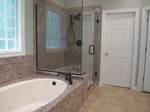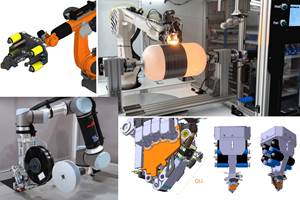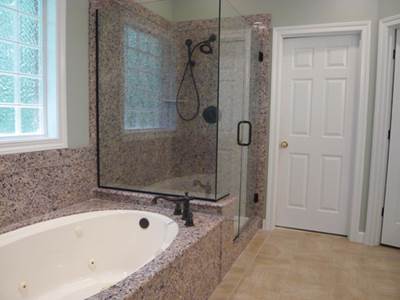Cast polymer categories
The cast polymer industry is multifaceted. Its many products, however, can be grouped into three general categories, differentiated by the materials and manufacturing methods used to make them.
The cast polymer industry is multifaceted. Its many products, however, can be grouped into three general categories, differentiated by the materials and manufacturing methods used, as follows:
Engineered composites is the new moniker put forth by the International Cast Polymer Assn. (ICPA, part of the American Composites Manufacturers Assn., Arlington, Va.) for what previously was known as cultured marble or cultured stone. This material, which is made by hand or with automated equipment, features a low-viscosity orthophthalic unsaturated polyester resin filled with calcium carbonate or alumina trihydrate (ATH) and pigments, at about 75 to 78 percent filler loading, behind a surface gel coat that contains UV stabilizers to ensure color stability and gloss. An alternative process, called spray granite, sprays a mix of granite granules and a clear gel coat onto a substrate for a granite look. Bathroom vanity tops, basins and shower surrounds are the most common applications. The basic polyester resin can be adjusted by various combinations of glycols (e.g., ethylene, propylene), acids (e.g., maleic anhydride) and monomers (e.g., styrene) to create slightly more elongation or impact-resistance, or longer gel time, for a particular manufacturer’s product. Although early products combined shots of dark pigmented resin and filler with a lighter resin mixture to create swirled veined marble, today’s engineered composites tend to have a “chopped” look that more closely resembles granite. Heavily pigmented resin, in this case, is added in chunks and blobs to the base resin. Better gel coats now prevent the chalking, or whitish discoloration, and scratches that can occur over time, and they enable the use of darker, richer colors, such as CCP Composites’ (Kansas City, Mo.) IMEDGE product, says Charles Martin, a sales manager at the company. Even matte finishes, which are created by sanding the gel coat, are sometimes specified to give homeowners more options, he adds.
Solid surface products consist of resin and filler (at 50 to 65 percent loading) without a surface gel coat. DuPont’s (Wilmington, Del.) well-known Corian material, introduced in 1965, is a notable example. Solid surfaces require a resin with higher strength and heat-distortion temperature to withstand the abuse common to kitchens (soaps, acids and hot pans) and institutional settings, such as hospitals and schools. Solid color products typically use fine ATH filler, says Jack Simmons, vice president at filler manufacturer ACS International (Tucson, Ariz.). He adds that for granite-effect products, the fillers are coarser than those used in engineered composites. Solid surface products are typically manufactured with isophthalic unsaturated polyester with UV stabilizers, and they also can be made with more costly, but more stain-resistant, polymethyl methacrylate (PMMA) thermoset acrylic, or a blend of the two. With PMMA or in blends, acrylic replaces styrene, so less UV stabilizer is needed. Acrylic content also reduces resin viscosity while improving air release, adds Simmons.
Visually, solid surface products can range from pure white to myriad color schemes, created by incorporating pigments and colored granules, or specks, that give the illusion of natural granite. The granules are typically made by casting sheets of pigmented polyester, thermoplastic or acrylic resins, then crushing them to the desired size and adding them to the resin. More recently, specks have been replaced with many different sizes of particulate to more nearly replicate natural stone.
Engineered stone, on the other hand, is essentially man-made granite. It is a broad category that includes engineered quartz, polymer concrete and engineered marble stone. For the 50 or so manufacturers who use the large-scale Breton method, developed by Italian equipment manufacturer Breton Spa (Castello di Godego, Italy) in the 1960s, it is the most capital equipment-intensive and complex of the cast polymer processes. But some cast polymer manufacturers are starting to produce engineered stone by other means, using more cost-effective, if labor-intensive, methods (see main story).
The patented Bretonstone technology, properly referred to as a “compaction by vibrocompression vacuum process,” uses elastomeric molds in which a crushed stone/resin mix is cast on a moving belt. Natural stone aggregate — usually specific types of minerals, such as quartz, or waste rock from quarries — is combined with a small amount of resin (between 5 and 10 percent for a filler loading of 90 to 95 percent), pigments and proprietary additives. The mix is heated and compressed under vacuum in a large press. The vibration helps compact the mixture and results in an isotropic slab with virtually no porosity that can be cut to fit any installation. Slabs are sold under many trade names, including Zodiaq, CaesarStone, HanStone and more, in hundreds of custom colors.
Although epoxy is sometimes used as the engineered stone matrix, polyester resin is more common, according to Interplastic Corp. - Thermoset Resins Div.’s (St. Paul, Minn.) casting group business manager Daryl Francis. And Mark Harber, AOC Resins’ (Collierville, Tenn.) cast polymer business manager, explains that engineered stone resins must possess low shrink and high resilience for the best performance.
Related Content
The next evolution in AFP
Automated fiber placement develops into more compact, flexible, modular and digitized systems with multi-material and process capabilities.
Read MoreThe potential for thermoplastic composite nacelles
Collins Aerospace draws on global team, decades of experience to demonstrate large, curved AFP and welded structures for the next generation of aircraft.
Read MorePlant tour: Albany Engineered Composites, Rochester, N.H., U.S.
Efficient, high-quality, well-controlled composites manufacturing at volume is the mantra for this 3D weaving specialist.
Read MoreSulapac introduces Sulapac Flow 1.7 to replace PLA, ABS and PP in FDM, FGF
Available as filament and granules for extrusion, new wood composite matches properties yet is compostable, eliminates microplastics and reduces carbon footprint.
Read MoreRead Next
Cast polymer market: On the upswing
Postrecession, this commodity industry is emerging stronger and going global as competitive pressures encourage innovation.
Read MorePlant tour: Daher Shap’in TechCenter and composites production plant, Saint-Aignan-de-Grandlieu, France
Co-located R&D and production advance OOA thermosets, thermoplastics, welding, recycling and digital technologies for faster processing and certification of lighter, more sustainable composites.
Read More“Structured air” TPS safeguards composite structures
Powered by an 85% air/15% pure polyimide aerogel, Blueshift’s novel material system protects structures during transient thermal events from -200°C to beyond 2400°C for rockets, battery boxes and more.
Read More
























